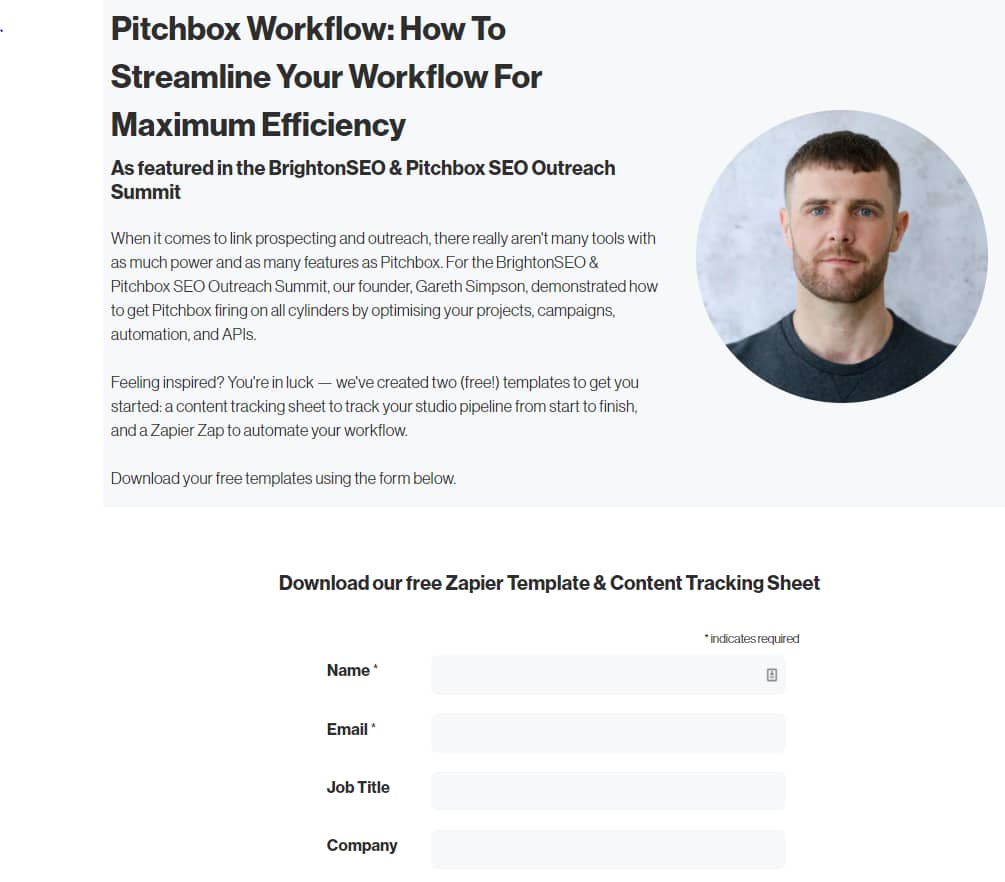
Great content is your gateway to business growth.
Optimised content drives traffic, helping your site rise in the SERPs, and getting your brand in front of potential customers.
But while this strategy is certainly important, SEO takes time to see the effect, so while this is still a worthwhile approach, you won’t get immediate success.
If you really want to see results from your content marketing, you need to adopt an active approach, and that means getting creative.
Intrigued? We’ve got you sorted—read on for five creative ways of using content to promote your business.
Lean on fun and visual creative assets
Whoever said business-promoting content couldn’t be fun?
A simple, visually-attractive game that ties into your business’ product or service offering is a great way to promote your brand in a fun, engaging way.
Just because your business might be more prosaic than others (for instance, if you operate in the financial sector), it doesn’t mean you can’t find a fun angle for your content. Indeed, it actually strengthens the need to stand out against your competitors.
Check out this example from animal medication firm, Animed Direct:

Image Daily Mail
Released during the Christmas period, this is a simple seek-and-find puzzle, where players need to identify 14 potential (and real) hazards for animals within a house.
Simple? Yes. Fun? Of course—who doesn’t love a puzzle? And it promotes the value of Animed Direct in an engaging way. Wins all round!
Pick a specific element of your business that solves your customers’ pain points, and consider how that could be turned into a game that demonstrates that benefit.
Keep it simple, and don’t overthink it. A simple spot-the-difference puzzle is enough to convey your business’ product or service in a fun, creative way.
Your design team is well-placed to create such an asset, or you could use a simple graphic design tool (such as Gravit Designer) for a DIY job.
It’s also worth tying it into a current event or trend to increase the chance of it landing coverage. Animed Direct gave their puzzle a Christmas theme, but Easter, Valentine’s Day, or even Black Friday are other examples that can give your creative asset a current edge.
Reach out to your media contacts to pitch your asset. As a soft, fun activity, it is an easy win for journos. Indeed, the proof is in the pudding — the Animed Direct asset above got featured in the Mail Online, evidence that a simple but fun creative asset can promote your business nicely.
Get creative with visual digital PR
Digital PR focuses on outreach to news and industry publications.
Digital PR gives you visible, high-value coverage on authoritative sites and publications that is earned, rather than just paid for.
There are myriad avenues open to you here.
Press releases are one such option, as they quickly and easily turned into a news piece by a journalist.
While not necessarily creative in themselves, a well-written and unique press release does require a degree of creativity to get right.
A good press release includes, but is by no means limited to, the following:
- A good headline that sums up the story (and why it matters).
- A strong lede: the opening paragraph that succinctly captures the key elements of the story. Essentially: who, what, where, when, and why?
- Press contacts: who should the journalist reach out to for more information?
- Quote: a quote from the relevant person or people, offering detail and insight into the story.
The key is to keep it concise, while focusing on what the story is and why it matters to the journo’s readers. It needs a hook, something that is actually newsworthy. Ask yourself: why should people care?
Not every update or development about your business is worth pitching to a publication.
For starters, your press release needs to matter to people outside of your business. Making a new hire might be an exciting event internally, but it’s not newsworthy in itself.
However, launching a new product using an exciting and innovative technology? That’s newsworthy.
If you’re unsure, reach out to some friendly journos first to validate your idea — there’s no point wasting time on writing a press release if no journalists are going to pick it up.
But digital PR also spans digital assets too, including infographics.
Engaging infographics are a (relatively) straightforward way of capturing audience attention through newsworthy data.
They let you identify and highlight issues that matter to your customers (and to a journo’s readership), and then position your own brand’s product or service as a solution to these pain points.
Original research is best here, as it gives your infographic and journo pitch authority and credibility.
For first-timers, the best way to do this is by working with a dedicated media research company. They know their stuff, and can provide more targeted, on-the-ground research that yields solid, interesting data.
Pick out the key stats from this data and turn it into a visually-appealing infographic. Identify those that matter to your target audience (that is, prospective customers). Data that taps into their pain points (or makes them realise a pain point that they have, but have never considered in depth) are the most relevant, so highlight these front-and-centre in your infographic.
Of course, data on its own isn’t enough to warrant coverage. Use short, concise copy to highlight why the data matters, and how it relates to your audience (and that of your journo too).
Share your value with talks & landing pages
Using talks (and accompanying landing pages) is a surefire way of gaining links for your brand..
The benefits of promoting your business through talks and conferences are numerous:
- Thought leadership: offering fresh, unique insight into your field positions you and your brand at the forefront of your industry—and ahead of your competitors.
- Brand building: show to others who you are, what you do, and why you’re the best at it.
- Lead generation: talks are often attended by prospective leads, particularly if you’re an agency or consultancy.
Sure, it’s not as creative as the other points on this list. But it is a creative way to repurpose your existing content into a stellar talk that delivers relevant (and, ideally, actionable) value to your audience.
Find those videos or articles on your site that enjoy the most traffic and engagement and transform them into an insightful presentation. Break it down into its key points, and lean on multimedia and visuals to jazz it up a little and make your message more accessible.
Naturally, as an SEO agency, this is something Seeker has employed in the past to great effect.
But a webinar or talk in itself won’t promote a business.
While it certainly highlights your expertise, for best results, you want to actively direct relevant and engaged traffic to your site.
This means creating a dedicated landing page that offers some extra value to the visitor, building on what was discussed in the talk, as a lead generation tool.
This is also something Seeker has employed in the past. Our team have spoken at a number of conferences in the past, and we always try to build a landing page to accompany each one.
For instance, Gareth recently spoke at BrightonSEO & Pitchbox’s SEO Outreach Summit, where he shared his expert tips on optimising your workflow in Pitchbox.
In his talk, Gareth touched on a few essential tools and templates that his audience could use to achieve this.
We offered two of these, a Zapier template and a content tracker sheet, on our landing page, in return for their name and email address.

Image Seeker Digital
It’s a simple offer, and it’s content that Gareth already had up his sleeve from his own work in Pitchbox. But by offering it for free off the back of a useful talk to a relevant audience, we can use it to promote our business, services, and skills to the right people at the right time.
What really counts here is value: what does your audience need, and how can you provide it to them in an accessible (and free) way?
Deliver relevant value through training
In the same vein as the above, you might consider looking to dedicated training courses as means of promoting your business.
Lots of companies use training and education as a way of promoting themselves, particularly in the B2B sector.
Every business’ customers have their pain points, and brands are in a position to deliver solutions for those pain points through training.
Link building is what we do best, and our Managing Director Gareth Simpson and Head of Outreach Laura Slingo have taken to the BrightonSEO stage more than once to share Seeker’s expertise.
Alongside this, we also offer tailored training courses for in-house teams, teaching SEO to everyone from copywriters and PR executives to brand managers and developers.
Training courses offer the same kind of value as webinars or talks — thought leadership, brand building, and so on — but ten times over.
Longer, more comprehensive, and more structured than a simple webinar, training courses let you connect with prospective collaborators or clients in a deeper way.
The conversation is also less passive than in a talk, as course attendees are able to speak with the trainer and ask questions. This strengthens the relationship between the trainer’ business and their attendees (or prospective clients).
The best training sessions are those that offer genuine value to your audience, whilst also presenting your business as an expert and solution that your audience might also use themselves.
Launch a link building campaign for inbound traffic
You likely know already that value of links for SEO. A diverse backlink profile signals to search engines that your site is credible, trustworthy, and authoritative. It shows Google that your site deserves a higher place in the SERPs.
But beyond this, links are also built for a reason: to be clicked.
We’ve discussed already the benefits of guest posting for SEO, but this strategy also lets you tap into relevant and engaged audiences for traffic too.
A link building campaign launched with the specific goal of driving traffic to a site requires careful prospecting.
Build a list of high-quality, authoritative, and relevant prospects based on your business keywords and reach out to them with the offer of a guest post.
Make clear what it is you want and outline the value of your business.
Nailing your value proposition is essential here. The key is not what matters to you or your business, but what’s in it for your prospect.
Explain who you are, why your business is relevant to your prospect, and how you can add value to their site.
Relevancy is also crucial here. A link for a link’s sake won’t get you the right kind of traffic clicking on your link. It’s important to target the right kind of websites too, those whose audience overlaps with yours.
The way you place your link in the content is important too. The value of your target link has to be outlined in such a way that it is essential to the piece, without the content simply rehashing what it provides to audiences.
Highlight how your business’ target page offers further value to your reader — a free tool, a guide, and so on — and incentivise them towards it.
Want to get creative and promote your business through content but don’t know where to start?
This is what we do best at Seeker—creative marketing strategies that get your business seen by the right people at the right time.
If you want to promote your brand and win links and coverage that get it noticed, drop us a line—we can help you get where you need to be.
